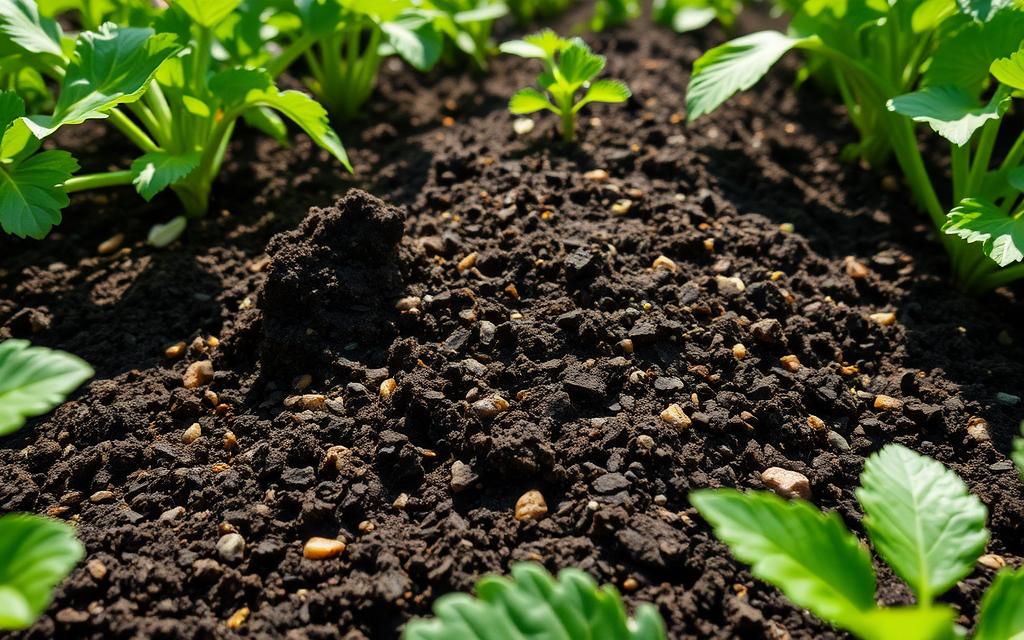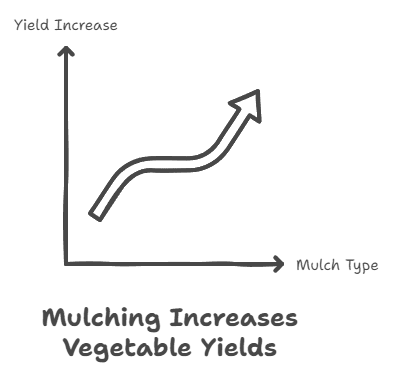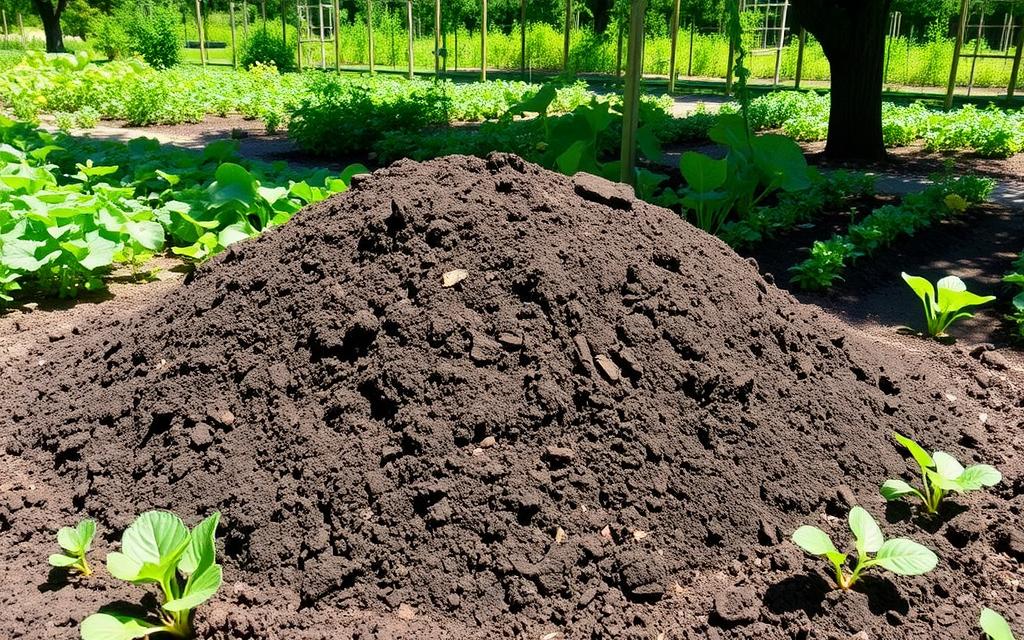Ever wondered how to make your vegetable garden thrive? The secret might be in the soil. Topsoil, the top layer of soil, is full of nutrients that plants need. It can turn your garden into a lush, full place. But are you using it right?
Key Takeaways
- Topsoil is the top 2-8 inch layer of soil where essential nutrients and growing processes occur.
- Gardeners often add 1-2 inches of fresh topsoil annually to vegetable gardens for optimal plant health.
- Topsoil types like clay, silt, and loam have unique characteristics that impact plant growth.
- Adding topsoil can improve soil quality, drainage, and texture for easier planting and weeding.
- Understanding your topsoil composition is key to promoting thriving, nutrient-rich vegetables.
What is Topsoil?
Nutrient-Rich Layer for Plant Growth
Topsoil is the top layer of soil in gardens and yards, 2 to 8 inches deep. It’s full of organic matter and microorganisms that help plants grow. This layer is where plants get their nutrients, water, and sunlight.
It’s different from planting soil or potting soil, which are made for specific uses. Topsoil is the natural soil that makes a garden healthy. Most plant roots live here, getting what they need to grow.
Topsoil is cheaper than other soils but might not have enough organic matter for gardens. Many gardeners add compost or manure to improve it for their plants.
“The richness of the soil is the foundation of the wealth of the nation.”
– Thomas Jefferson
Knowing about topsoil helps you make better choices for your garden. You can use it well and fix problems like how to stop earwigs eating plants and how to stop caterpillars from eating my plants naturally.

Types of Topsoil
Choosing the right topsoil for your vegetable garden is key. Each type, like clay, silt, sand, and loam, has its own benefits and challenges for plants. Let’s look at the main types of topsoil and what makes them special:
- Sand Topsoil: Sand topsoil is rich in nutrients but has little organic matter. It forms over centuries and is found near coasts and deserts. It drains well but may not hold moisture for all plants.
- Silt Topsoil: Silt topsoil keeps a lot of moisture but lacks nutrients. It’s found in flood plains. It can get compacted, making it hard for roots to grow.
- Clay Topsoil: Clay topsoil holds water well but has little organic matter. It’s found in low-lying areas or near water. It’s heavy and dense, which can be tough for plants.
- Loam Topsoil: Loam topsoil is a mix of silt, sand, and clay. It retains water and has good nutrients. This makes it great for many vegetables and fruit trees.
- Chalk Topsoil: Chalk topsoil is very alkaline because of limestone. It’s found in areas like river banks. It absorbs moisture but can dry out fast.
- Peat Topsoil: Peat topsoil comes from waterlogged areas like bogs. It’s made from dead plant matter over time, making it rich soil.
Knowing about these topsoil types helps you pick the best for your cactus plant with red top, how to stop squirrels eating plants, and how to stop deer from eating hosta plants. The right topsoil ensures your garden grows well and gets the nutrients it needs.
| Topsoil Type | Characteristics | Ideal for |
|---|---|---|
| Sand | High in nutrients, low in organic material, well-draining | Root vegetables, heat-loving crops |
| Silt | High moisture retention, low in nutrients, prone to compaction | Water-intensive crops, wetland plants |
| Clay | Excellent water retention, lacking in organic material, dense and heavy | Leafy greens, root vegetables |
| Loam | Well-balanced mixture of sand, silt, and clay, good drainage and nutrient levels | Wide variety of vegetables and fruit trees |
| Chalk | Alkaline due to limestone, good moisture absorption, prone to drying out | Plants tolerant of alkaline soil |
| Peat | Organic, nutrient-rich soil formed in waterlogged areas | Plants requiring acidic soil conditions |
Understanding these topsoil types helps you choose the best for your garden. This ensures your plants grow well in the right soil conditions.
Benefits of Adding Topsoil
Improving Soil Quality
Adding topsoil to your garden can greatly improve your plants’ health and productivity. Topsoil is full of nutrients that help with drainage, enrich the soil, and make it easier to plant and weed. Gardeners often suggest adding 1 or 2 inches of fresh topsoil each year to replace what’s lost.
Heavy rains or construction can wash away topsoil, and too many weeds or foot traffic can deplete its nutrients. Adding more topsoil regularly can make your garden better by improving the soil and making it more neutral, perfect for most plants.
Topsoil is key for topsoil for plants, creating the best environment for your veggies. Knowing the benefits of adding topsoil helps you stop squirrels from digging up plants and gives your tomato plants the nutrients they need.
“Incorporating fresh topsoil into your garden on a regular basis can work wonders for the overall health and productivity of your plants.”
Studies reveal that topsoil can last about eight years if stored right, while potting soil only lasts two years. Bagged topsoil can last up to 8 years if stored properly, making it a smart choice for your garden’s future.
Acquiring and Applying Topsoil
There are many ways to get topsoil for your vegetable garden. You can buy it in bulk for big projects or get it in bags at garden centers or home improvement stores. Adding topsoil in the spring is best, letting the nutrients mix well with the soil for the growing season.
In the fall, adding topsoil as a top dressing is also good. This lets the nutrients break down over winter, ready for spring. Make sure to mix any lumpy soil well before spreading it out.
To spread the topsoil, pour it directly or use a shovel. After spreading, rake or broom it to level the ground. Spraying the soil with water helps keep it in place and prevents it from being blown away.
| Soil Mix | Roma Tomato Yield (lbs/plant) |
|---|---|
| Mel’s Mix | 7.0 |
| Perfect Soil Recipe | 5.3 |
| Bagged Soil | 1.34 |
| In-Ground Garden | 2.59 |
These stats show how different soils affect vegetable yields, like Roma tomatoes. Choosing and applying the right topsoil boosts your garden’s growth and productivity.
For successful topsoil use, mix it well, spread it evenly, and keep it moist. These steps help your soil support healthy plant growth. This is true for white stuff on top of soil indoor plant, how to stop animals digging in plant pots, or mold on top of soil indoor plants.
topsoil for indoor vegetable garden
Creating a thriving indoor vegetable garden starts with the right soil. Topsoil, the top layer of earth, is key for feeding, absorbing water, and supporting your plants. By picking the best topsoil, you help your leafy greens, tomatoes, and peppers grow well indoors.
For indoor gardens, choose topsoil that’s clean and made for indoor use. These soils keep moisture in, drain well, and give plants the nutrients they need. Adding compost or well-aged manure can make the soil even better, giving your plants what they need to grow strong.
Getting your soil ready is important for an indoor garden. Before planting, mix the topsoil with any extra nutrients well. This helps roots grow strong and keeps plants healthy, preventing jade plant top heavy problems.
While can i use top soil for plants might seem easy, think about what your garden needs. Some plants do better in certain mixes or systems, so check what they like. With some trial and care, you’ll find the best topsoil for your planting topsoil indoors.
The quality of your soil is key to your indoor garden’s success. High-quality topsoil and proper preparation help create a great place for your plants to grow and produce well.
Tilling and Soil Preparation
Getting your soil ready is key for a great vegetable garden. Tilling, or mixing the soil, helps a lot. It makes the soil air-rich, keeps weeds and bugs away, and gets it ready for seeds.
When to Till
The best time to till is in the spring, when it’s dry and warm. This is usually from March to early June. It’s perfect for planting and lets the soil settle before you plant seeds.
But, tilling too much can hurt the soil. It can cause erosion and bring up weed seeds. Instead, you can add topsoil or potting mix to keep the soil healthy without tilling a lot.
- Tilling makes the soil air-rich, which helps roots grow better.
- Do it when the soil is dry, usually in the spring from March to June.
- Avoid tilling too much, as it can harm the soil and bring up weeds.
- Think about adding topsoil or potting mix instead of tilling often to keep the soil healthy.
| Tilling Techniques | Best Use |
|---|---|
| Cultivators | Smaller, lighter machines for existing gardens |
| Tillers | Bigger machines for new gardens or large areas |
Knowing when and how to till your garden makes it perfect for your plants. A well-prepared soil with the right nutrients is key for a big harvest.
Fertilizing and Nutrient Needs
Keeping the right balance of nutrients in your vegetable garden is key for healthy plants and lots of produce. Each plant needs different nutrients, and how often you fertilize depends on the type of plants you grow.
Most plants that make fruits and veggies need a lot of nutrients to grow well and produce a lot. To make sure your topsoil vs garden soil or lawn soil vs topsoil has what your plants need, you can use organic and inorganic fertilizers.
Instead of regular fertilizers, you could use high-quality best organic soil for vegetables like compost or supplements like fish emulsion or bone meal. These natural helpers can make your soil richer and give your plants what they need.
| Nutrient Ratio | Recommended Usage |
|---|---|
| 3-4-4 | Initial vegetable garden fertilization |
| 3-4-6 | Tomatoes, to prevent blossom-end rot |
| Nitrogen side dressings | Cabbage, cauliflower, broccoli, peas, beans, cucumbers, muskmelons, peppers, eggplants, tomatoes, sweet corn, spinach, kale, mustard, turnip greens |
When you use fertilizers, whether they’re organic or synthetic, always follow the label’s instructions. Adjust the amount based on your garden’s size. Using the right methods, like spreading granular fertilizers and watering them in, helps your plants soak up the nutrients.
A balanced, nutrient-rich soil is the key to a great vegetable garden. By knowing what your plants need and using the right fertilizers, you can help them grow well and give you a big harvest.
“The usage of organic fertilizers such as fish, kelp, and rock dust has been a practice for centuries, providing a historical perspective on sustainable agriculture practices.”
Companion Planting and Biodiversity
Mixing different plants in your garden helps keep pests away. By growing a mix of vegetables, fruits, herbs, and flowers, you draw in helpful insects. These insects can eat pests or keep them away, cutting down on the need for harmful chemicals.
Natural Pest Control
Planting different plants together can create a safe garden. For example, topsoil for vegetable garden with basil keeps aphids away. Growing corn, beans, and winter squash together makes the soil better and stops weeds.
- Herbs like thyme, mint, and catnip keep pests away.
- Flowers such as marigolds and nasturtiums bring in ladybugs and lacewings. These insects eat pests.
- Using row covers can also protect plants from pests.
Keeping a variety of seeds is important because one type of plant can get sick easily. A garden with many types of plants is stronger and healthier.
| Companion Plant | Benefit |
|---|---|
| Basil | Repels aphids, attracts beneficial insects |
| Marigolds | Deters nematodes and other pests |
| Nasturtiums | Attracts aphids, protecting other plants |
| Thyme, Mint | Natural pest repellents |
Using garden soil versus topsoil and planting together helps your garden. It makes a healthy, diverse garden that uses nature to fight pests and keep plants strong. This way, you use fewer chemicals and help your garden and the environment.
“Biodiversity is the foundation of life on our planet, and it is being lost at an alarming rate. Preserving and restoring biodiversity is a fundamental requirement for sustainable development.”
Mulching and Moisture Retention
Mulching is key for a healthy vegetable garden. As mulch breaks down, it fights weeds and improves soil quality. You can use wood chips, compost, straw, coco shells, leaves, or newspaper as mulch.
Mulching has many benefits. Studies show it can increase yields by up to 30 percent. Organic mulches add nutrients to the soil as they decompose. They also help keep soil moist, which is good for your plants.
When adding mulch, think about the timing. Put a 1-2 inch layer of fine mulch around plants when they’re a few inches tall. This keeps moisture in and weeds out. But remember to leave a 3 cm gap around the stem to prevent suffocation.
Some mulches work better with certain plants. For cool-weather crops, straw, leaves, or newspaper are good choices. They keep soil cool. For warm-weather veggies, plastic mulches can heat up the soil by up to 25 degrees.
Using a soaker hose with mulching helps keep soil moist. This combo creates the best conditions for your garden to flourish.

“Mulching is a simple yet powerful way to boost the health and productivity of your vegetable garden.”
Conclusion
Adding topsoil to your vegetable garden can really help plants grow better and produce more. It gives plants the nutrients they need, helps them absorb water, and creates a healthy place for them to grow. By knowing about the different types of topsoil and how to use them, you can make your garden perfect for growing vegetables indoors or outside.
Don’t forget to think about soil preparation, adding fertilizers, planting different plants together, and keeping the soil moist. These steps will make your topsoil work better and help you get a lot of fresh, tasty vegetables.
Using topsoil in your garden lets you can you use top soil for vegetable garden and make your garden soil better. With the right mix of top soil vs garden soil and good gardening habits, you’ll have a garden full of topsoil for vegetable garden. This means you’ll have plenty of fresh produce all year.
FAQ
What is topsoil?
What are the different types of topsoil?
What are the benefits of adding topsoil to a vegetable garden?
How do I acquire and apply topsoil?
Can I use topsoil for an indoor vegetable garden?
When is the best time to till the soil?
How often should I fertilize my vegetable plants?
How can I use companion planting to control pests naturally?
How does mulch benefit the vegetable garden?
Source Links
- What Is Topsoil and What Are Its Benefits?
- The Best Tips to Prepare Garden Soil | Platt Hill Nursery | Blog & Advice
- 5 Common Types of Bagged Soils: What’s Best for Veggies?
- Top Soil Versus Potting Soil: What’s the Difference?
- Types Of Topsoil: The Ultimate Guide | EZ-Screen
- HGS Hydro
- Best Soil For Growing Vegetables
- Topsoil vs Potting Soil: 4 Key Differences You Should Know
- The Difference Between Topsoil, Compost & Potting Mix | Milorganite
- Benefits Of Using A Topgrade Garden Soil
- 3 Raised Bed Soil Mixes Compared – The Beginner’s Garden
- Best Soil For Growing Vegetables
- Can You Use Topsoil In Pots & Potted Plants? – Alsoils+
- The Best Soil for an Indoor Vegetable Garden
- Topsoil vs Potting Soil: 4 Key Differences You Should Know
- How to Prepare Garden Soil For Planting
- How to Till and Cultivate Your Garden in 10 Easy Steps
- Planting Directly in Soil3
- Garden Fertilizer Tips – How And When To Fertilize
- Let’s Grow! How and When to Fertilize Your Vegetable Garden
- Garden Grow-How: Planning Your Diverse Organic Garden
- Companion Planting: 43 Combinations for Maximum Yield
- Choosing the Right Mulch for Vegetable Gardens | Gardener’s Supply
- A Comprehensive Guide to Using Mulch in a Vegetable Garden
- HGS Hydro
- DIY Potting Soil Mix for Indoor and Container Plants


